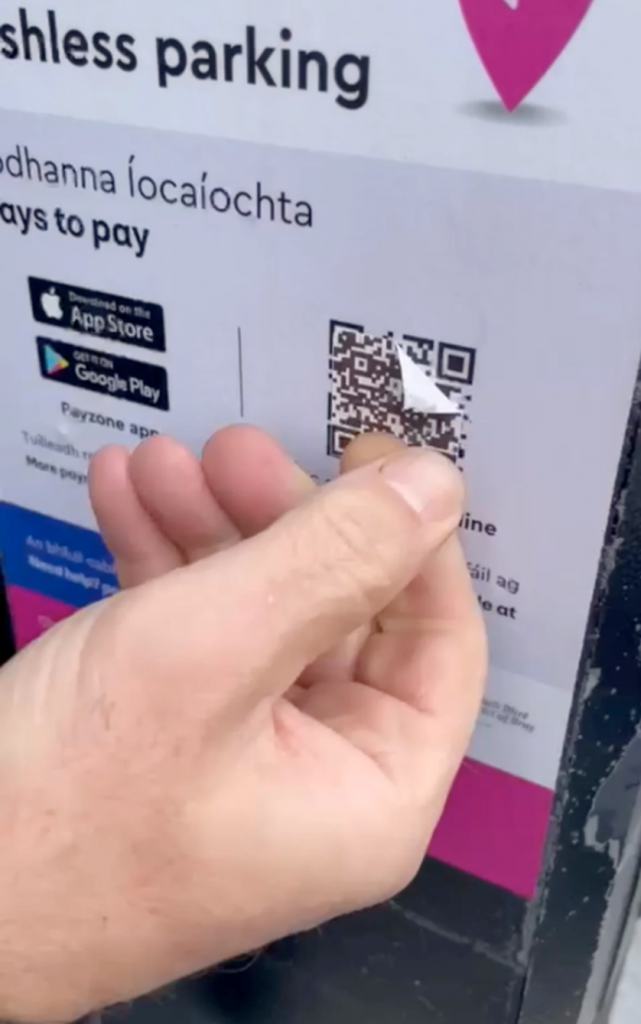Man
Professional
- Messages
- 3,225
- Reaction score
- 1,078
- Points
- 113
How scammers in Ireland deceive inattentive drivers.
A new fraud scheme involving fake QR codes placed on parking signs has been identified in Ireland. Users of the social network Mastodon discussed how scammers use fake stickers with modified codes that redirect victims to fake payment sites.
It all started when a certain Alastair McKinstry reported a suspicious QR code on one of the parking signs. The whole trick of this fraud is that the parking sign is real, and the QR code originally really allowed you to pay for your stay in the parking lot.

However, on top of the original code, the attackers pasted a fake one, which not every owner of personal transport can notice. And if he notices, he may not pay attention to it - you never know, the payment details have changed, and the code has been re-pasted. This, apparently, is what is being counted on.
In the comments to the post, other Mastodon users noted that such stickers often look quite official, and therefore it becomes impossible to recognize the catch if you do not look and try to peel off the top layer with your fingernail.
The discussion also touched on the problem of trust in payment applications and QR codes in general. Participants expressed dissatisfaction with the fact that more and more services require the use of smartphones for payment, limiting access to services for those who prefer cash payments.
Some noted that similar schemes have already been used in other countries, including the UK, where scammers have tricked themselves into obtaining personal data through fake links. The lack of strict checks on QR codes opens up wide opportunities for such abuses.
Cybersecurity experts warn that such stickers can be used not only to steal funds, but also to collect confidential information. One of the commentators noted that scammers can change the addresses of sites on stickers, making them even more difficult to track.
Opinions were also voiced on the network about the need to increase the level of vigilance among users and introduce more reliable protection methods. However, many agree that the responsibility for preventing fraud should lie with service providers, not the consumers themselves.
The problem of this kind of fraud raises the question of the transparency and security of digital payment methods. More and more users are in favor of returning to cash payments, considering them safer in the face of a growing number of digital threats.
Source
A new fraud scheme involving fake QR codes placed on parking signs has been identified in Ireland. Users of the social network Mastodon discussed how scammers use fake stickers with modified codes that redirect victims to fake payment sites.
It all started when a certain Alastair McKinstry reported a suspicious QR code on one of the parking signs. The whole trick of this fraud is that the parking sign is real, and the QR code originally really allowed you to pay for your stay in the parking lot.

However, on top of the original code, the attackers pasted a fake one, which not every owner of personal transport can notice. And if he notices, he may not pay attention to it - you never know, the payment details have changed, and the code has been re-pasted. This, apparently, is what is being counted on.
In the comments to the post, other Mastodon users noted that such stickers often look quite official, and therefore it becomes impossible to recognize the catch if you do not look and try to peel off the top layer with your fingernail.
The discussion also touched on the problem of trust in payment applications and QR codes in general. Participants expressed dissatisfaction with the fact that more and more services require the use of smartphones for payment, limiting access to services for those who prefer cash payments.
Some noted that similar schemes have already been used in other countries, including the UK, where scammers have tricked themselves into obtaining personal data through fake links. The lack of strict checks on QR codes opens up wide opportunities for such abuses.
Cybersecurity experts warn that such stickers can be used not only to steal funds, but also to collect confidential information. One of the commentators noted that scammers can change the addresses of sites on stickers, making them even more difficult to track.
Opinions were also voiced on the network about the need to increase the level of vigilance among users and introduce more reliable protection methods. However, many agree that the responsibility for preventing fraud should lie with service providers, not the consumers themselves.
The problem of this kind of fraud raises the question of the transparency and security of digital payment methods. More and more users are in favor of returning to cash payments, considering them safer in the face of a growing number of digital threats.
Source
